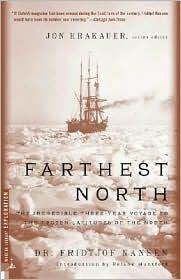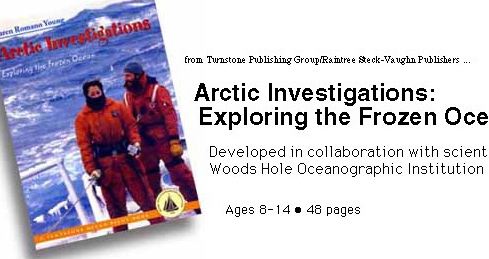To prepare for my expedition this summer I have been reading two books recommended by my expedition leader Rick Krishfield. The first is Farthest North by Fridtjof Nansen. (1999: Modern Library; Abridged edition)
 The long out-of-print Farthest North, one of the first titles in the library's Exploration series, recounts Dr. Fridtjof Nansen's epic 1893 pursuit of the North Pole. Like Jon Krakauer, the series' editor, Nansen was the chronicler of one his age's most sensational adventures. But he was also much more: statesman and explorer, scientist and sex symbol, Nansen's singular character and remarkable spirit demand attention and respect. (Courtesy MOdern Library)
The long out-of-print Farthest North, one of the first titles in the library's Exploration series, recounts Dr. Fridtjof Nansen's epic 1893 pursuit of the North Pole. Like Jon Krakauer, the series' editor, Nansen was the chronicler of one his age's most sensational adventures. But he was also much more: statesman and explorer, scientist and sex symbol, Nansen's singular character and remarkable spirit demand attention and respect. (Courtesy MOdern Library)
After successfully crossing the Greenland ice cap in 1888, F. Nansen turned his exploring attention towards the North Pole. After considering the evidence of past Arctic expeditions, Nansen began developing theories about ocean tides and currents, and hypothesized that he could drift towards the North Pole by freezing a specially-designed ship into the ice pack. Everyone thought he was crazy. Not only did he lack a safe retreat, he also was testing a novel and controversial ship design that, if failed, would most certainly lead to the demise of the expedition. Nonetheless, Nansen was able to lead his "illogical scheme of self-destruction" (so called his expedition by American explorer Adolphus Greely) and departed on his ship the Fram (meaning "forward") in summer of 1893 and was frozen into the ice north of the Siberian Islands by September. The ship proved it could easily withstand the pressures of the ice pack, and it began to drift with the ice pack.
Nansen and his crew of 12 took careful measurement of currents, depth, temperature and salinity. It became clear that the drift would not allow the Fram to reach the North Pole, so Nansen and Johansen left the ship via sledge for points north. This part of the story is fantastic, a true adventure written by a scientists, a story-teller and a man driven by the power of the unknown.
Over the past few weeks I have carried this book around, to track meets, doctor's offices, chess tournaments and have been quite surprised by the number of people who have read it. We all talk about the sled dogs. If you read the book, you will know why.
The second is Arctic Investigations: Exploring the Frozen North by Karen Romano Young (2000: Steck-Vaughn Company).
 A frozen ocean...creaking, cracking ice...and polar bears outside your door. These are just a few of the challenges facing scientists who want to understand the five million square milse of chilly water called the Arctic Ocean. How do they get there? What do they do there? And what are they discovering? In Arctic Investigations, you’ll see what it’s like to work on top of the world. (Courtesy of Turnstone Publishing.)
A frozen ocean...creaking, cracking ice...and polar bears outside your door. These are just a few of the challenges facing scientists who want to understand the five million square milse of chilly water called the Arctic Ocean. How do they get there? What do they do there? And what are they discovering? In Arctic Investigations, you’ll see what it’s like to work on top of the world. (Courtesy of Turnstone Publishing.)
This interesting and educational tale describes life on a research vessel in the Arctic Ocean. about both the history of Arctic exploration and the scientific research ongoing today.
My favorite fact from this book is this: the word Arctic comes from the Greek work Arktos, meaning bear. Now why would a bear have any significance in the Arctic? Yes, there are polar bears, but that's not it. Think up, as in the sky.....
Have you heard of The Big Dipper? The Little Dipper? The formal names of these constellations (groups of stars) are Ursa Major and Ursa Minor, and Ursa is the Latin word for bear. The North Star, part of the Little Dipper, is almost directly over the geographic North Pole, and has been used by sailors for centuries to mark which direction is north. So this is the connection between Arctic, Arktos, Ursa and bear. Do you think this is where the term "bear right" came from?
There are many other interesting facts and stories in this book, from how scientists make measurements to determine whether global warming is actually happening to an Arctic food chain to why foraminifera make good thermometers. And on pg. 38 is a picture of Rick deploying a water motion sensor beneath the ice. After reading this book, I have a much better idea of what life will be like next summer.
Gerty Ward says: See you soon!

